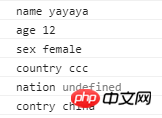
This article brings you a summary of the methods of traversing objects (5 types) and traversing arrays (6 types) in js. It has certain reference value. Friends in need can refer to it. I hope it will be useful to you. Helps.
1. Traversal object method
1.for...in
Traversal output are the properties of the object itself and the enumerable properties on the prototype chain (excluding Symbol properties). The final output of the properties on the prototype chain shows that the enumerable properties of the object itself are traversed first, and then
eg:
var obj = { 'name': "yayaya", 'age': '12', 'sex': 'female' };
Object.prototype.pro1 = function() {};//在原型链上添加属性
Object.defineProperty(obj, 'country', {
Enumerable: true //可枚举
});
Object.defineProperty(obj, 'nation', {
Enumerable: false //不可枚举
})
obj.contry = 'china';
for (var index in obj) {
console.log('key=', index, 'value=', obj[index])
}Output result:

##2.Object.keys() Traversing the object returns an array containing the enumerable properties of the object itself (excluding the Symbol property).
eg:
var obj = { 'name': "yayaya", 'age': '12', 'sex': 'female' };
Object.prototype.pro1 = function() {}
Object.defineProperty(obj, 'country', {
Enumerable: true,
value: 'ccc'
});
Object.defineProperty(obj, 'nation', {
Enumerable: false //不可枚举
})
obj.contry = 'china';
Object.keys(obj).forEach(function(index) {
console.log(index, obj[index])
});
3.Objcet.getOwnPropertyNames() Outputs an array of enumerable and non-enumerable properties of the object itself, and does not output properties on the prototype chain
eg:
var obj = { 'name': "yayaya", 'age': '12', 'sex': 'female' };
Object.prototype.pro1 = function() {}
Object.defineProperty(obj, 'country', {
Enumerable: true,
value: 'ccc'
});
Object.defineProperty(obj, 'nation', {
Enumerable: false //不可枚举
})
obj.contry = 'china';
Object.getOwnPropertyNames(obj).forEach(function(index) {
console.log(index, obj[index])
});
##4.Reflect.ownKeys() Returns all properties of the object itself, regardless of whether the property name is a Symbol or a string, or whether it is enumerable.
eg:
var obj = { 'name': "yayaya", 'age': '12', 'sex': 'female' };
Object.prototype.pro1 = function() {}
Object.defineProperty(obj, 'country', {
Enumerable: true,
value: 'ccc'
});
Object.defineProperty(obj, 'nation', {
Enumerable: false //不可枚举
})
obj.contry = 'china';
Reflect.ownKeys(obj).forEach(function(index) {
console.log(index, obj[index])
});
5. _.keys Using the traversal method of the underscore plug-in can only traverse the enumerable attributes of the object itself
eg:
var obj = { 'name': "yayaya", 'age': '12', 'sex': 'female' };
Object.prototype.pro1 = function() {}
Object.defineProperty(obj, 'country', {
Enumerable: true,
value: 'ccc'
});
Object.defineProperty(obj, 'nation', {
Enumerable: false //不可枚举
})
obj.contry = 'china';
console.log(_.keys(obj)); 2. Array traversal method
2. Array traversal method
1.forEacheg:
var arr = ['a', 'b', 'c', 'd'];
arr.forEach(function(value, index) {
console.log('value=', value, 'index=', index);
})

can be traversed Each item is processed accordingly and an array composed of the results of each function call is returned. eg:
var arr = ['a', 'b', 'c', 'd'];
arr.map(function(item, index, array) {
console.log(item, index);
})

eg:
var arr = ['a', 'b', 'c', 'd'];
for (var i = 0; i

eg:
var arr = ['a', 'b', 'c', 'd'];
for (var i in arr) {
console.log('index:', i, 'value:', arr[i])
}

(es6)Only traverses the value, not the subscript, but can traverse the attributes of the Symbol data type. This method is used to traverse all data structures. The unified methodeg:
var arr = ['a', 'b', 'c', 'd'];
for (var value of arr) {
console.log('value', value)
}
 ##6.Use the underscore plug-in
##6.Use the underscore plug-in
eg:
var arr = ['a', 'b', 'c', 'd'];
var _ = require('underscore');
_.each(arr, function(value, index, arr) {
console.log(value, index, arr)
})
 Related recommendations:
Related recommendations:
js code for traversing the properties of objects
Two ways to traverse arrays in js
The above is the detailed content of Summary of methods for traversing objects (5 types) and traversing arrays (6 types) in js. For more information, please follow other related articles on the PHP Chinese website!




